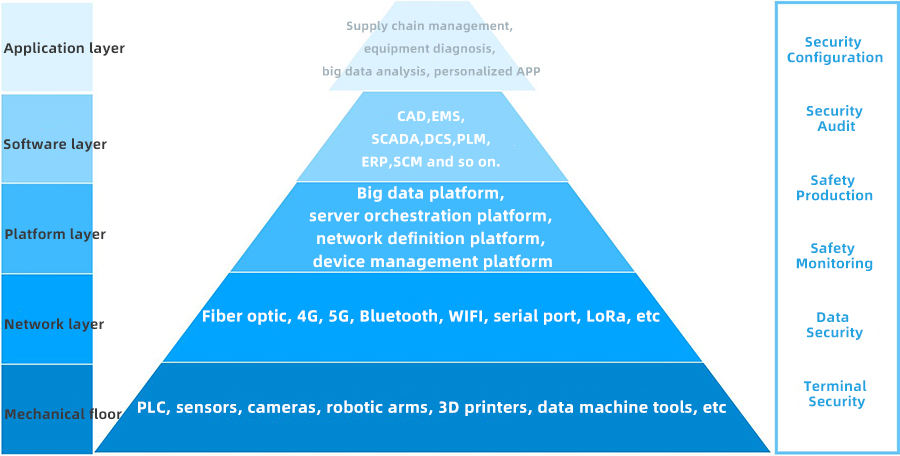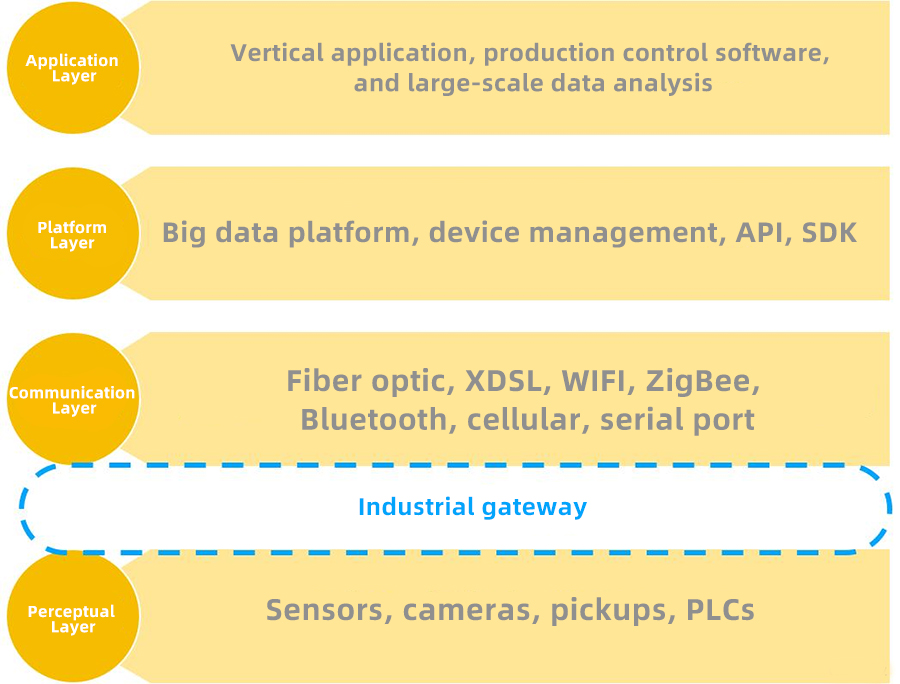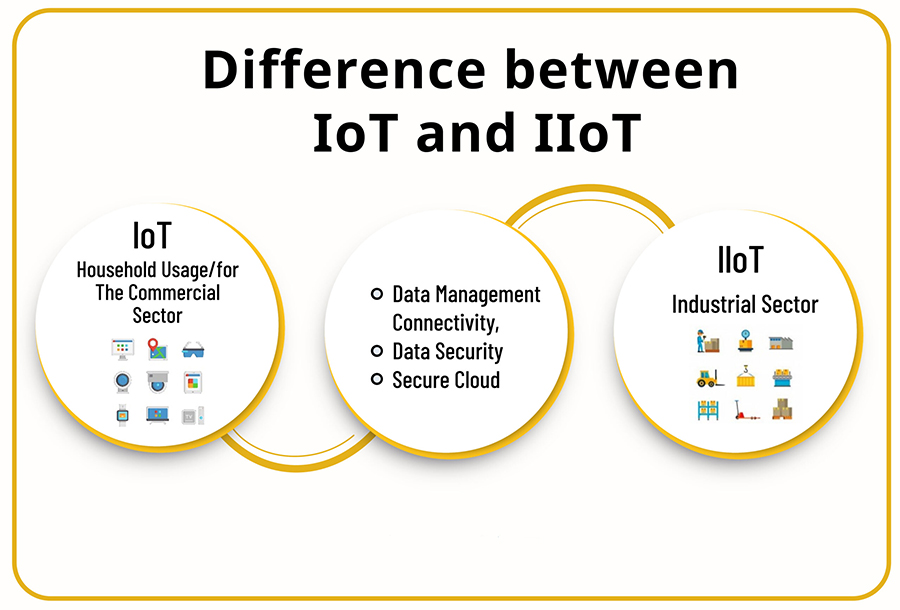Industrial Internet of Things (IIoT) is the Internet of Things applied in industry, which is a system of interconnected sensors, meters and other devices and industrial applications of computers connected by network, including manufacturing and energy management.Internet connectivity allows for data collection, exchange, and analysis, which helps to improve productivity and efficiency, as well as other economic benefits. IIoT evolved from a distributed control system (DCS), which uses cloud computing to improve and optimize process control and achieve a higher degree of automation.
The difference between the industrial Internet and the industrial Internet of things is one word, but the contents covered are quite different.
1) Industrial Internet architecture
The industrial Internet is not the industrial Internet, but the industrial Internet. It connects people, data and machines in the industrial production process, digitalizing, automating, intellectualizing and networking the industrial production process, realizing the "circulation of data", improving production efficiency and reducing production costs.
From the perspective of technical architecture, industrial Internet includes equipment layer, network layer, platform layer, software layer, application layer and the overall industrial security system. Compared with the traditional Internet, there is an additional device layer.

(Industrial Internet Architecture)
The equipment layer is responsible for collecting data and preliminary calculation, and executing production actions;
The network layer is responsible for the transmission and forwarding of information;
The platform layer is responsible for the arrangement of network, storage, computing and other infrastructure;
The software layer is responsible for the development and design of industrial production process, the implementation of production control and information management software.
The application layer is responsible for embodying the value of the industrial Internet and forming solutions and applications in different vertical fields and industries.
The industrial safety system is responsible for the safety of each industrial production, covering the operation, maintenance and replacement of equipment, security certification at the network level, security vulnerabilities at the platform software level, etc.
The industrial Internet of Things is the "infrastructure" of the industrial Internet. It connects the device layer and the network layer, laying a solid foundation for the platform layer, the software layer and the application layer. The device layer also includes the edge layer. In general, the industrial Internet of Things covers cloud computing, network, edge computing and terminals, and opens up the key data streams in the industrial Internet from bottom to top.
2) Industrial Internet of Things architecture
The industrial Internet of Things is divided into perception layer, communication layer, platform layer and application layer.
The perception layer is mainly composed of sensors, visual perception and programmable logic controllers (PLC). On the one hand, it collects data such as vibration wave, temperature, humidity, infrared, ultraviolet, magnetic field, image, sound wave stream and video stream, and transmits them to the network layer to reach the upper management system to help it record, analyze and make decisions.On the other hand, it collects the instructions issued or programmed from the upper management system and executes the equipment actions.
The communication layer is mainly composed of various network devices and lines, including optical fiber and xDSL with fixed network lines, as well as GPRS, 3G, 4G, 5G, WiFi, ultrasonic, ZigBee, Bluetooth and other communication modes through radio wave communication, which mainly meet the communication needs of different scenarios.
The platform layer mainly deposits the data transmitted at the bottom layer into platform data after association and structured analysis, connects and perceives downward, and provides a unified programmable interface and service protocol upward, which reduces the design complexity of the upper software and improves the coordination efficiency of the overall architecture, especially at the platform level.Provide data decision for production efficiency, equipment detection, etc.
The application layer is mainly based on the needs of different industries and fields, landing as vertical application software, through the integration of platform layer precipitation data and user configuration control instructions, to achieve efficient application of terminal equipment, and ultimately improve production efficiency.
A gateway is arrange between that sensing lay and the communication layer, and the gateway isolates a terminal sensor and a controller from an upper-layer network port, so that on one hand, the service logic complexity of the sensor and the control is reduced, and on the other hand, the parsing cost of an upper-layer application on a data protocol is reduced.

(Industrial Internet of Things Architecture)
Generally speaking, the industrial Internet covers the industrial Internet of things. The industrial Internet is to realize the full interconnection of "people, machines, and things," and to pursue digitalization. The industrial Internet of Things emphasizes the connection of "things and things" and pursues automation.Industrial Internet of Things is a cross-network system of Internet of Things and Internet, and also a breakthrough in the deep integration of automation and informatization.
3) Relationship between the two

(Relationship between Industrial Internet and Industrial Internet of Things)
In the industrial Internet system, industrial software is the soul and the center of the overall control arrangement. Industrial Internet of Things takes data as its blood and provides various useful information and nutrients for industrial Internet.
With the advent of the 5G era, what kind of development will the industrial Internet of things usher in?
4) When the Industrial Internet of Things Meets 5G
5G has the characteristics of large bandwidth, low latency and wide coverage, which solves the network problems of industrial Internet of Things. However, 5G is not a silver bullet at this stage, and there are still many challenges in the transformation and upgrading of the industrial Internet of Things using 5G.
Base station construction challenges:
5G has been commercialized, but the construction of 5G base stations has not yet been completed, 5G signals have not yet covered a large area, and 5G applications are limited.
Cost Challenges:
5G phenomenal application has not yet appeared, which means that the terminal demand of 5G is still at a low level, resulting in low production and high cost of 5G chips, and the cost of modules is tens of times higher than that of 4G. When 5G truly realizes the popularization from base stations to application terminals, the industrial Internet of Things will also step up to a new level in terms of network deployment efficiency.
Standard challenges:
The standards of industrial Internet of Things devices and systems are not uniform, and industrial software needs to coordinate various devices and be compatible with the private protocols of different manufacturers in order to achieve automation.
Talent Challenges:
The industrial chain of industrial Internet is relatively long, and the demand for talents is very high, while China is relatively short of talents in this area.
Security challenges:
Cloud computing, especially public cloud, can not dispel the security concerns of business owners, and after privatization, it brings non-standard problems. These problems are not only the difficulties in the development of industrial Internet of Things, but also the opportunities for entrepreneurs.
In the future, what subdivisions of the industrial Internet of things will usher in the wind? Here are some of my thoughts and judgments:
Industrial Gateway:
In the 5G era, industrial gateways will have higher performance networks and become an important infrastructure for edge computing. Localized functions such as image recognition, path planning and pattern recognition can be solved at the gateway level.
Industrial Internet of Things Security:
Network security is a higher-level network demand. At the network level of the industrial Internet of Things, there are several major demands, such as interconnection, high-performance network and security network. With the digital transformation of enterprises, the demand for network security of industrial Internet of Things will also usher in explosive growth.
Industrial intelligent robots:
The demand for industrial robots in China is strong, and the current purchasing volume is the first in the world, but the density of industrial robots is insufficient, and the independent ability of R & D and production of industrial robots is insufficient, which contains huge development space.
Network module
After the popularization of industrial Internet and industrial Internet of Things, every device and sensor needs corresponding transmission modules, so the demand for network modules will also usher in explosive growth.
2020 is destined to be the key year for industrial development. Taking advantage of the east wind of "new infrastructure", the demand for remote collaboration and cloud management in industrial manufacturing is urgent, and the popularization of industrial Internet and industrial Internet of Things will usher in new opportunities.

